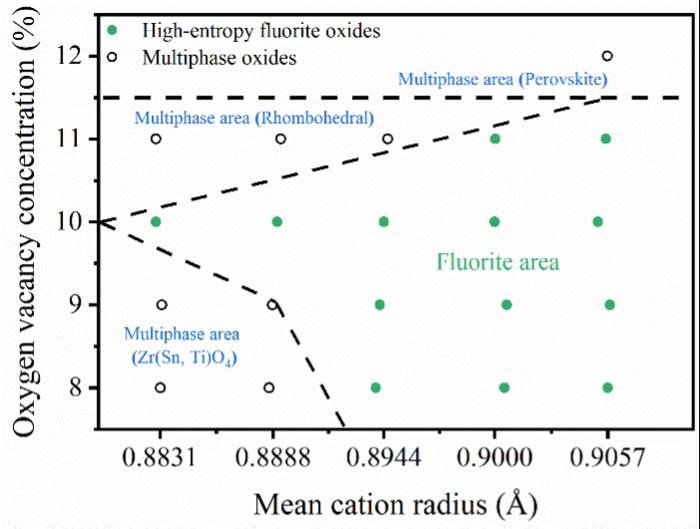Reviewed by Lexie CornerNov 25 2024
Recent research published in the Journal of Advanced Ceramics proposed a new design strategy focusing on mean cation radius and oxygen vacancy concentration, leading to the discovery of new HEFO compositions. This new design approach offers a promising avenue for developing HEFOs with tailored properties for thermal protection applications. The study was carried out by scientists from the Beijing Jiaotong University and the North China Electric Power University.
 The formability of the fluorite structure is influenced by both r and Ovac. It is evident that when r is approximately 0.8831 or 0.8888 Å, only the samples with 10 % Ovac formed single-phase HEFOs. This suggests that a high or low Ovac is not conducive to the formation of single-phase HEFOs when the samples are the same r. The main secondary phase in multiphase area of the figure is marked. Image Credit: Journal of Advanced Ceramics, Tsinghua University Press.
The formability of the fluorite structure is influenced by both r and Ovac. It is evident that when r is approximately 0.8831 or 0.8888 Å, only the samples with 10 % Ovac formed single-phase HEFOs. This suggests that a high or low Ovac is not conducive to the formation of single-phase HEFOs when the samples are the same r. The main secondary phase in multiphase area of the figure is marked. Image Credit: Journal of Advanced Ceramics, Tsinghua University Press.
Recent studies indicate that factors such as the standard deviation of cationic radii, configurational entropy, and the stabilization of Ce4+ influence the formation of single-phase high-entropy fluorite oxides (HEFOs). However, these observed patterns are limited to specific synthesized material systems and have notable constraints. Additionally, the range of elements incorporated into these materials is relatively narrow, limiting the ability to fully harness the benefits of high-entropy materials and their extensive compositional diversity.
Inspired by the synthesized HEFOs and the stabilization mechanism of doped fully stabilized zirconia, we believe that the mean cation radius (r) and oxygen vacancy concentration (Ovac) should be important factors affecting the formation of HEFOs.
Cuiwei Li, School of Mechanical, Electronic and Control Engineering, Beijing Jiaotong University
Cuiwei Li added, “We chose (Ce0.2Zr0.2Hf0.2Sn0.2Ti0.2)O2 as the main object, and CaO was used to introduce oxygen vacancies. The effects of the CaO content on the formability of single-phase (Cax(Ce0.2Zr0.2Hf0.2Sn0.2Ti0.2)1−x)O2−δ (x = 0–0.3) were firstly investigated. Then, a grid search was performed near the two single-phase compositions (Cax(Ce0.2Zr0.2Hf0.2Sn0.2Ti0.2)1−x)O2−δ (x = 0.2 and 0.22)) to systematically study the influence of the r and Ovac on the formability of single-phase (CaxCey1Zry2HfzSnzTiz)O2−δ.”
We found that an appropriate increase in r and the introduction of Ovac contribute to the formability of HEFOs. The above research findings were further validated in three new HEFOs designed based on the valence combination strategy, which is composed of elements with different valences ranging from +3 to +6.
Cuiwei Li, School of Mechanical, Electronic and Control Engineering, Beijing Jiaotong University
Thermal energy in electrically insulating materials is primarily transported by phonons, whose movement is hindered mainly by various phonon-scattering mechanisms, including phonon-phonon interactions, grain boundary scattering, and defect scattering.
Studies have revealed that the low thermal conductivity of high-entropy fluorite oxides (HEFOs) can be attributed to the presence of numerous oxygen vacancies, as well as to quality fluctuations and stress field variations arising from their chemical complexity.
In this paper, we considered the influence of phonon scattering on thermal conductivity from the aspects of mass disorder, size disorder, and Ovac. For samples with the same Ovac, a negative correlation exists between thermal conductivity and size disorder, as well as mass disorder. Aggregation of oxygen vacancies resulting from high Ovac levels can weaken the phonon scattering effect.
Cuiwei Li, School of Mechanical, Electronic and Control Engineering, Beijing Jiaotong University
“Based on the findings of our study, we propose a new design approach for HEFOs with low thermal conductivity. This approach involves two steps: first, determining the element combinations based on the valence combination and element properties; second, within the range of r and Ovac capable of forming HEFOs, mass disorder, and size disorder should be increased as much as possible, and Ovac should be adjusted to a level that prevents agglomeration,” added Cuiwei Li.
“This approach emphasizes the careful consideration of the content of high-valence cations in the composition. This is because high-valence cations typically have relatively small radii, and their introduction can lead to a reduction in Ovac,” said Cuiwei Li.
This new design strategy will aid in the expansion of HEFO compositions and further performance research while also offering valuable insights into the composition design of other high-entropy oxides. The prepared HEFOs, characterized by low thermal conductivity, are anticipated to find applications in thermal protection.
This research was supported by the Fundamental Research Funds for the Central Universities (Nos. 2023YJS062 and 2022JBZY025), the State Key Laboratory of New Ceramic and Fine Processing at Tsinghua University (No. KFZD201902), and the Beijing Government Funds for the Constructive Project of Central Universities.
Journal Reference:
Chen, G., et al. (2024) A novel approach for the composition design of high-entropy fluorite oxides with low thermal conductivity. Journal of Advanced Ceramics. doi.org/10.26599/jac.2024.9220942.